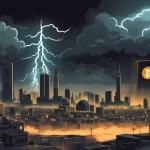Iran Launches deBlock 2025: Aiming to Be Middle East’s Crypto Hub

Iran’s Bold Bid to Become a Crypto Powerhouse at deBlock 2025
Iran has thrown its hat into the cryptocurrency ring with the launch of deBlock 2025, its first international blockchain conference held in Tehran on November 6-7. This event marks a pivotal moment, signaling the country’s ambition to not just adopt digital assets but to emerge as a dominant player in the Middle East’s decentralized tech landscape, driven by high-level political will and a strategic vision to reshape its economic future.
- Historic Event: deBlock 2025, Iran’s inaugural international blockchain conference, hosted in Tehran.
- Economic Target: Aiming for a 10% digital economy share in the national economy via crypto integration.
- Regional Goal: Positioning as a Middle East crypto hub with global standards and partnerships.
deBlock 2025: Iran’s Crypto Coming-Out Party
Hosted at the IRIB International Conference Center, deBlock 2025 wasn’t just another tech gathering—it was Iran’s loud and clear message to the world: we’re serious about blockchain. With delegates from over 15 countries, including heavyweights from the BRICS alliance (Brazil, Russia, India, China, South Africa, and now Iran among others) and Central Asian representatives, the forum showcased Tehran’s resolve to stake a claim in the global crypto arena, as highlighted in coverage of Iran’s intent to become a crypto hub at its first blockchain event. High-ranking officials, led by Mohammad Bagher Ghalibaf, Speaker of the Iranian Parliament, didn’t mince words. They’re not here to play with Bitcoin on the sidelines; Iran wants a full-blown crypto-based financial ecosystem—think regulated trading platforms, tokenized real-world assets (turning physical things like property into digital tokens tradable on a blockchain), and using digital currencies for foreign trade.
The stakes are sky-high. Iran’s National Development Plan sets a lofty target: grow the digital economy to 10% of the national economy. Shamseddin Hosseini, Chairman of the parliamentary economic committee, laid it out plain and simple:
“The digital economy’s share must reach 10% of the country’s total economy, and achieving this goal is impossible without crypto assets.”
Ghalibaf echoed this urgency, framing digital assets as more than a trend—they’re a lifeline. He stated:
“Crypto-assets and blockchain technology are not merely an opportunity, but a necessity for the future of Iran’s and the world’s economy.”
For newcomers, this means Iran sees cryptocurrencies as tools to revolutionize how money moves, free from the constraints of traditional banks or borders. It’s a bold vision, and deBlock 2025 was the stage to unveil it.
Economic Necessity: Sanctions and Survival
Iran’s push into crypto isn’t born out of mere tech enthusiasm—it’s a survival tactic. Decades of international sanctions have choked its access to global financial systems, leaving traditional banking and trade routes often inaccessible. Cryptocurrencies, with their decentralized, borderless nature, act like a financial escape hatch, sidestepping the locked doors of systems like SWIFT. Picture this: an Iranian exporter settling a deal with a Russian buyer using Bitcoin, no banks or intermediaries needed. That’s the kind of freedom Iran craves, and it’s why Ghalibaf is pushing for a structured approach to make it happen. He emphasized:
“The development of a national roadmap for crypto assets is an undeniable imperative.”
But survival is just the starting point. Iran’s eyeing something bigger—regional dominance as the Middle East crypto hub. This isn’t about dabbling in speculative tokens; it’s about building infrastructure where digital currencies are woven into everyday finance. Ghalibaf elaborated on this broader vision:
“The perspective on crypto assets should not be limited solely to mining or buying and selling. To fully utilize the capacities of this industry, we need the comprehensive development of a crypto-based financial ecosystem.”
Translation? Decentralized banking (financial services without middlemen), cross-border payments on the blockchain, and even digitizing assets like real estate or oil into tokens. For a country under economic siege, that’s not just innovation—it’s a potential game-changer.
Regional Power Play: BRICS and International Ties
Geopolitics is at the heart of Iran’s crypto strategy, and its membership in BRICS is a key piece of the puzzle. This alliance of emerging economies is increasingly looking for alternatives to Western-dominated financial systems, and shared cryptocurrencies could be the ticket. Ghalibaf highlighted how digital assets might strengthen economic ties within BRICS-Plus interactions, enabling transactions without the interference of traditional gateways. For Iran, this isn’t just tech—it’s a geopolitical chess move to bolster financial independence.
A major step toward global credibility came at deBlock 2025 with a memorandum of understanding signed with Trescon Global, a Dubai-based tech event organizer. This partnership aims to host a version of the Iranian conference in Dubai, opening doors to foreign investment and international exposure. Reza Soltani, executive director of deBlock, was clear about the potential:
“Iran has the potential to become the regional hub for decentralized technologies. The collaboration with Trescon can attract foreign investment, enhance international credibility, and expand technological partnerships with BRICS countries.”
This isn’t just about a shiny event—it’s Iran signaling to the world that it’s open for business in the blockchain space. Aligning with global crypto standards and forging partnerships like this could help shed its image as a financial outcast and repaint it as a serious innovator in decentralized tech.
Roadblocks to a Crypto Revolution
Let’s pump the brakes on the hype train for a second. Iran’s path to becoming a cryptocurrency hub is littered with landmines. For starters, its history with crypto is a rollercoaster of bans and crackdowns. Back in 2021, the government halted Bitcoin mining operations due to massive energy consumption causing blackouts—those power-hungry mining rigs don’t play nice with a strained national grid. Iran’s got some of the cheapest electricity in the world, which makes it a magnet for miners, but without sustainable solutions like renewables or off-grid setups, this could remain a sticking point. Environmental pushback and energy shortages aren’t small hurdles; they’re giant red flags that need addressing before any “crypto utopia” talk gets traction.
Then there’s the regulatory mess. Iran’s flip-flopped on crypto harder than a politician dodging a scandal—consistency isn’t their forte yet. Past bans on mining and trading show that internal consensus isn’t a given, and without ironclad rules, there’s a real risk of digital assets being used for illicit stuff like money laundering or sanctions evasion on a scale that could invite even harsher global backlash. Geopolitical tensions add another layer of chaos. Iran’s ambitions might spook Western powers or skittish neighbors, turning this tech push into a diplomatic hot potato.
On the flip side, Iran’s not flying blind. Its tech-savvy population and knack for economic workarounds—think underground forex markets during sanction peaks—mean there’s fertile ground for decentralized tech to take root. The buzz at deBlock 2025, with international eyes watching, shows genuine interest. If they play their cards right, this could be a case study in nation-state adoption that even Bitcoin maximalists can’t ignore. But let’s not kid ourselves—if crypto utopias were built on conference speeches, we’d all be millionaires by now. Reality’s a tougher miner to crack.
Technical Vision: Building a Crypto Ecosystem
What does a crypto-based financial ecosystem even look like for Iran? It’s not just about hodling Bitcoin or flipping altcoins. The vision likely involves a multi-pronged approach. Bitcoin could serve as a store of value, a hedge against fiat volatility in a sanction-hit economy. Ethereum or other smart contract platforms might power decentralized apps (dApps) for finance, trade, or even tokenized assets—imagine Iranian oil or real estate as digital tokens traded globally. There’s also chatter of a central bank digital currency (CBDC), a government-backed digital rial, though that raises eyebrows among decentralization purists who see CBDCs as surveillance tools dressed up as innovation.
Scalability is a beast, though. Bitcoin’s network isn’t built for high-volume transactions, and Ethereum’s gas fees can sting. Iran would need to prioritize infrastructure—think layer-2 solutions or even a national blockchain, though that risks clashing with the censorship-resistant ethos of true crypto. Cybersecurity is another minefield; a state-backed ecosystem could be a juicy target for hackers or rival nations. Still, if Iran can balance open innovation with necessary guardrails, it might carve out a unique niche in the blockchain world. The question is whether they’ll lean toward Bitcoin’s purity or dabble in altcoin versatility to fill gaps BTC can’t.
Global Implications: A Domino Effect?
Iran’s crypto gamble isn’t happening in a vacuum—it could ripple across the globe. For nations under similar sanction pressures, like Venezuela or North Korea, Tehran’s moves might be a blueprint. Venezuela’s already tinkered with its Petro token (a flop by most accounts), but Iran’s broader ecosystem approach could inspire others to bet big on Bitcoin or decentralized systems as a middle finger to Western financial dominance. If successful, this might push Bitcoin adoption into overdrive, validating it as a global reserve asset beyond speculative hype. Even altcoin fans should perk up—Ethereum’s smart contracts or newer protocols could find a home in Iran’s tokenized economy.
But here’s the devil’s advocate angle: nation-state adoption risks turning crypto into just another government pawn. Bitcoin was born from cypherpunk ideals of freedom and privacy, not state agendas. If Iran—or any country—centralizes control over digital assets, it could undermine the very ethos that makes crypto revolutionary. And let’s toss in a spicy take: if Tehran starts hodling BTC en masse, Washington might panic and slap down anti-Bitcoin policies faster than you can say “blockchain blacklist.” Regulatory dominoes could fall, and not in a good way. The tension between state power and decentralization is a tightrope Iran will need to walk.
What This Means for Crypto Investors and Advocates
For Bitcoin maximalists in our audience, Iran’s play could be a massive “I told you so” moment—proof that BTC is the ultimate hedge against fiat collapse and geopolitical strife. If a sanctioned nation can leverage it for economic survival, imagine what widespread adoption could mean for its value long-term. Altcoin enthusiasts shouldn’t sleep either; Iran’s need for diverse blockchain solutions might spotlight platforms like Ethereum for smart contracts or newer chains tackling scalability. But temper the excitement—geopolitical chess doesn’t move at blockchain speed. Investors and advocates alike should watch this space closely, not for moonshot predictions (we don’t peddle that garbage), but for real-world evidence of crypto’s transformative grit.
Key Takeaways and Questions on Iran’s Crypto Push
- What is driving Iran’s cryptocurrency ambitions?
The goal is to grow the digital economy to 10% of the national economy, a target seen as unattainable without integrating crypto assets, alongside bypassing sanctions for financial independence. - How does Iran plan to become a Middle East crypto hub?
By adhering to global standards, building a comprehensive crypto financial ecosystem, and forging partnerships like with Trescon Global while leveraging BRICS for shared digital currency initiatives. - What are the major obstacles to Iran’s blockchain goals?
Energy constraints from mining, a history of regulatory inconsistency, cybersecurity risks, and geopolitical tensions could all hinder progress without careful navigation. - Why is crypto a geopolitical tool for Iran?
It offers a way to sidestep international sanctions, enable seamless cross-border trade, and strengthen economic ties within BRICS, reducing reliance on Western financial systems. - How might Iran’s moves impact the broader crypto space?
Success could spur adoption among other sanctioned nations, validate Bitcoin as a reserve asset, and highlight altcoin utility, though it risks clashing with decentralization principles if state control dominates.
Zooming out, Iran’s blockchain debut at deBlock 2025 is a high-stakes experiment in how a nation can harness decentralized tech to rewrite its economic story. It’s a gamble balancing innovation with regulation, global outreach with domestic grit. For Bitcoin purists, state involvement might stink of betrayal to the cypherpunk spirit. Yet, if Tehran pulls this off, it could prove crypto’s power to transform entire economies, not just portfolios. Could this spark a domino effect, nudging other sanctioned nations to double down on digital assets? The world’s watching as Iran takes its first audacious steps onto this uncharted ledger.



